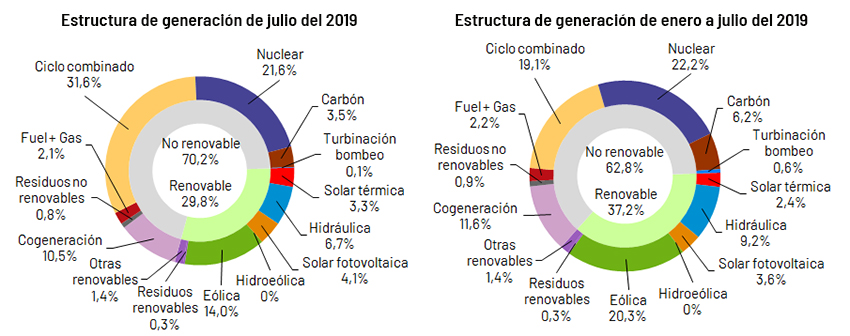In August, renewable energy produced 29.8% of electricity in Spain: wind energy 14%, solar thermal 3.3% and photovoltaic 4.1%. Until July, concentrating solar power produced 2.4% of electricity in Spain, wind turbines 20.3% and photovoltaic 3.6%. The group of renewables generated 37.2% until July.
The demand for national electricity in July is estimated at 24,283 GWh, 2.6% higher than that registered in the same month of the previous year. If the effects of the calendar and temperatures are taken into account, the figure drops 3.1% compared to July 2018.

In the first seven months of 2019, demand is estimated at 155,105 GWh, 1.4% less than in 2018. Again, once the influence of the calendar and temperatures has been corrected, demand is 2.3% lower to the one registered in the same period of the previous year.
In the month of July and according to estimated data today, the generation from renewable energy sources accounted for 29.8% of production. 51.5% of this month’s electricity production came from technologies that do not emit CO2.
With information available today, wind farm production in July reached 3,330 GWh, 29.3% higher than the same period last year, and accounted for 14% of national production.
In the peninsular electricity system, the demand for July is estimated at 22,768 GWh, 2.6% higher than that registered in the same month of the previous year. If the effects of the calendar and temperatures are taken into account, the figure drops 3.3% compared to July 2018.
In the first seven months of 2019, the demand for electricity in the Peninsula is estimated at 146,295 GWh, 1.5% less than in 2018. Again, once the influence of the calendar and temperatures has been corrected, the demand is 2.5% lower than that registered in the same period of the previous year.
During this month and according to estimated data today, 30.7% of the peninsular generation was of renewable origin and 53.7% came from technologies that do not emit CO2. For its part, wind energy registered 3,172 GWh, 27.8% higher than that of July last year, and contributed 14.2% to the ‘mix’.
In the Balearic Islands, the demand for electricity in July is estimated at 722,438 MWh, 5.4% higher than that registered in the same month of the previous year. If the effects of the calendar and temperatures are taken into account, the figure increases 1.3% compared to July 2018. In the first seven months of 2019, Balearic demand is estimated at 3,506,632 MWh, a 0, 8% more than in 2018.
Coal, with 33.3% of the total, was the first source of electricity generation in the Balearic Islands, where renewable technologies that do not emit CO2 represented 5.2%.
On the other hand, in the Canarian archipelago the demand for electricity is estimated at 753,309 MWh, 0.8% lower than that registered in July 2018. If the effects of the calendar and temperatures are taken into account, the figure drops by 1.5% with respect to the same month of the previous year. From January to July, demand in the Canary Islands is estimated at 5,064,385 MWh and increases 0.2% over the same period of the previous year.
In the month of July and according to estimated data, the combined cycle was the leading technology in the ‘mix’ of Canarian generation, with a contribution of 34.8%. Renewables and emission-free technologies accounted for 24% of the Canarian generation.